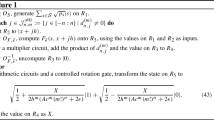Abstract
Monte Carlo integration using quantum computers has been widely investigated, including applications to concrete problems. It is known that quantum algorithms based on quantum amplitude estimation (QAE) can compute an integral with a smaller number of iterative calls of the quantum circuit which calculates the integrand, than classical methods call the integrand subroutine. However, the issues about the iterative operations in the integrand circuit have not been discussed so much. That is, in the high-dimensional integration, many random numbers are used for calculation of the integrand and in some cases similar calculations are repeated to obtain one sample value of the integrand. In this paper, we point out that we can reduce the number of such repeated operations by a combination of the nested QAE and the use of pseudorandom numbers (PRNs), if the integrand has the separable form with respect to contributions from distinct random numbers. The use of PRNs, which the authors originally proposed in the context of the quantum algorithm for Monte Carlo, is the key factor also in this paper, since it enables parallel computation of the separable terms in the integrand. Furthermore, we pick up one use case of this method in finance, the credit portfolio risk measurement and estimate to what extent the complexity is reduced.
Similar content being viewed by others
Notes
This means the loss which arises if he defaults. In general, it is estimated by the product of the loan amount and the loss given default, the ratio of the amount which the bank fails to recover.
Of course, regardless of whether it is done in a classical or quantum way, Monte Carlo integration based on PRNs can induce additional errors, since PRNs are not truly random but deterministic. Every PRN generator does not have perfect statistical properties, for example, numbers in a PRN sequence inevitably have correlations to some extent. As far as the authors know, for PRN sequences which are widely used today, no established way to estimate errors in Monte Carlo integration due to statistical poorness is known. In many practical cases, we check randomness of a given PRN sequence through some statistical tests and use it neglecting errors if it passes the tests. The inventor of PCG claims that it passes TestU01 [23], a widely-used test suite for PRN.
Note that \(N_\mathrm{RN}\) should be sufficiently smaller than the period of the PRN sequence. Conversely, we should choose a PRN sequence whose period is long enough.
Note that, in [7], \(U_P\) and \(U_J\) are represented by different symbols, \(P_{\mathrm{PRN}}\) and \(J_{\mathrm{PRN}}\), respectively.
In this paper, we take only the leading term for T-count, as in [13].
References
Montanaro, A.: Quantum speedup of Monte Carlo methods. Proc. R. Soc. Ser. A 471, 2181 (2015)
Suzuki, Y., et al.: Amplitude estimation without phase estimation. Quantum Inf. Process 19, 75 (2020)
Hull, J.C.: Options, Futures, and Other Derivatives. Prentice Hall (2012)
Glasserman, P.: Monte Carlo Methods in Financial Engineering. Springer (2003)
Woerner, S., Egger, D.J.: Quantum risk analysis. NPJ Quantum Inf. 5(1), 1–8 (2019)
Egger, D. J. et al.: Credit risk analysis using quantum computers. arXiv:1907.03044
Miyamoto, K., Shiohara, K.: Reduction of qubits in quantum algorithm for Monte Carlo simulation by pseudo-random number generator. Phys. Rev. A 102, 022424 (2020)
Rebentrost, P., et al.: Quantum computational finance: Monte Carlo pricing of financial derivatives. Phys. Rev. A 98(2), 022321 (2018)
Stamatopoulos, N., et al.: Option pricing using quantum computers. Quantum 4, 291 (2020)
Martin, A., et al.: Towards pricing financial derivatives with an IBM quantum computer. arXiv:1904.05803
Ramos-Calderer, S. et al.: Quantum unary approach to option pricing. arXiv:1912.01618
Vazquez, A.C., Woerner, S.: Efficient State Preparation for Quantum Amplitude Estimation. arXiv:2005.07711
Kaneko, K., et al.: Quantum pricing with a smile: implementation of local volatility model on quantum computer. arXiv:2007.01467
Orus, R., et al.: Quantum computing for finance: overview and prospects. Rev. Phys. 4, 100028 (2019)
Egger, D.J., et al.: Quantum computing for finance: state of the art and future prospects. IEEE Trans. Quantum Eng. 1, 3101724 (2020)
Bouland, A., et al.: Prospects and challenges of quantum finance. arXiv:2011.06492
Brassard, G., et al.: Quantum amplitude amplification and estimation. Contemp. Math. 305, 53 (2002)
Aaronson, S., Rall, P.: Quantum approximate counting, simplified. In: Symposium on Simplicity in Algorithms, pp. 24–32. SIAM (2020)
Grinko, D., et al.: Iterative quantum amplitude estimation. arXiv:1912.05559
Nakaji, K.: Faster amplitude estimation. arXiv:2003.02417
Tanaka, T., et al.: Amplitude estimation via maximum likelihood on noisy quantum computer. arXiv:2006.16223
O’Neill, M.E.: PCG: a family of simple fast space-efficient statistically good algorithms for random number generation. Harvey Mudd College Computer Science Department Tachnical Report (2014). http://www.pcg-random.org/
L’Ecuyer, P., Simard, R.: TestU01: AC library for empirical testing of random number generators. ACM Trans. Math. Softw. 33(4), 22 (2007)
Hörmann, W., Leydold, J.: Continuous random variate generation by fast numerical inversion. ACM Trans. Model. Comput. Simul. 13(4), 347 (2003)
Giovannetti, V., et al.: Architectures for a quantum random access memory. Phys. Rev. A 78, 052310 (2008)
Merton, R.C.: On the pricing of corporate debt: the risk structure of interest rates. J. Finance 29, 449 (1974)
Zhou, X., et al.: Methodology for quantum logic gate construction. Phys. Rev. A 62, 052316 (2000)
Selinger, P.: Quantum circuits of T-depth one. Phys. Rev. A 87, 042302 (2013)
Maslov, D.: On the advantages of using relative phase Toffolis with an application to multiple control Toffoli optimization. Phys. Rev. A 93, 022311 (2016)
Amy, M., Maslov, D., Mosca, M.: Polynomial-time T-depth optimization of Clifford+T circuits via matroid partitioning. IEEE Trans. CAD 33(10), 1476 (2014)
Kliuchnikov, V., et al.: Practical approximation of single-qubit unitaries by single-qubit quantum Clifford and T circuits. IEEE Trans. Comput. 65(1), 161 (2016)
Vedral, V., et al.: Quantum networks for elementary arithmetic operations. Phys. Rev. A 54, 147 (1996)
Author information
Authors and Affiliations
Corresponding author
Additional information
Publisher's Note
Springer Nature remains neutral with regard to jurisdictional claims in published maps and institutional affiliations.
Appendix A: Proof of (26)
Appendix A: Proof of (26)
We can transform \(H(\theta _j,M)\) to
Here, we used (9), some formulae on trigonometric functions and the relation \(\sin ^2(M({\tilde{\theta }}-\theta _j)\pi )=\sin ^2(M\theta _j \pi )\), which follows from \({\tilde{\theta }}\in I_M\). We can show that the second term in the parenthesis in (A1) is of subleading order with respect to 1/M, since the terms in the sum of cotangents over \({\tilde{\theta }}\in I_M\) nearly cancel out. In the limit that \(\theta _j \rightarrow {\tilde{\theta }}\) where \({\tilde{\theta }}\in I_M\), one term in the cotangent sum diverges but \(H(\theta _j,M)\) itself goes to 0 due to the overall factor \(\sin ^2(M\theta _j\pi )\). As a result, we get
Since \(|\sin ^2(M\theta _j \pi )\cos (2\theta _j\pi )/M|<1/M\), we finally obtain (26).
Rights and permissions
About this article
Cite this article
Kaneko, K., Miyamoto, K., Takeda, N. et al. Quantum speedup of Monte Carlo integration with respect to the number of dimensions and its application to finance. Quantum Inf Process 20, 185 (2021). https://doi.org/10.1007/s11128-021-03127-8
Received:
Accepted:
Published:
DOI: https://doi.org/10.1007/s11128-021-03127-8




